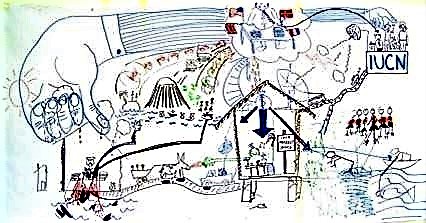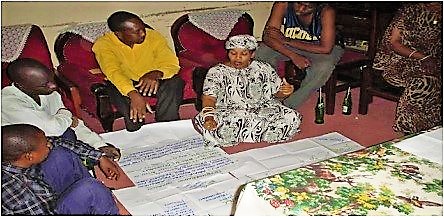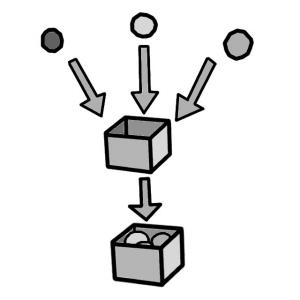Rich pictures are pictorial representations of environmental or social systems. They can help to organise complex situations and identify underlying problems by including all relevant elements and stakeholders of a system. Any technique may be used in drawing a rich picture, and they may be used in any situation, regardless of its complexity or the initial level of understanding of the problem. When done as part of a participatory planning approach, rich pictures can be a tool for encouraging discussion, interaction, and attaining a holistic understanding of a system by the stakeholders involved. They may be used at the beginning of participatory planning to better understand the system, or throughout participatory planning to evaluate progress and monitor change.
The goal of a rich picture is to better understand a complex situation in order to identify elements that need to be considered in problem solving. Among these important elements are stakeholders, their interests, and the interactions and connections between them (see also stakeholder identification, stakeholder importance and influence and stakeholder interests).Because rich pictures encourage thinking in terms of a system full of actors and stakeholders, they can help the user to understand the complexity of an entire situation by thinking holistically. This holistic thinking may help to see relationships and connections that may otherwise be missed (WAGENINGEN UR, 2008).

The key elements that should be included in a rich picture are structure, process, and concerns. For sustainable sanitation and water management, a good way to start to identify these elements is by going through the steps of Understand Your System.
- “Structure” includes anything that is slow to change, such as geographical situation or hierarchical structure of an association. For water and sanitation, some examples of “structure” may be the local hydrological system, water supply network, wastewater collection and treatment system, geographical distribution of water users (households, farmers, industries, etc.), and institutional and legal frameworks (see Understand Your System for more information).
- “Process”represents any transformations that occur within the system, such as goods exchange or information transfer. In water and sanitation, some examples of “process” might be water use, wastewater production, fertiliser use, or negotiations or dialogues between stakeholders. (see Understand Your System for more information).
- “Concerns”include all stakeholders’ motivations that influence their perspective. For water and sanitation, “concerns” might include drinking water quality, adequate water quantity, affordability, protection of natural resources, convenience, or dignity. “Concerns” may also include the relationships between different stakeholders and their perspectives toward different aspects of the system (for more information see Stakeholder Analysis starting by stakeholder identification factsheet).
Constructing a rich picture requires only a large drawing surface and writing utensils of different colours. A rich picture can be drawn in whatever way best suits the needs of the individual or group, and good drawing skills are not necessary. Anything that is seen as significant should be added to the rich picture, and care should be taken to identify all stakeholders who are involved in or may be affected by the system. Because it is important that the rich picture be clear to everyone involved, certain techniques are sometimes used to represent elements like stakeholder perspectives (such as thought bubbles) and relationships (such as crossed swords for stakeholder conflicts). These or other techniques may be used, as agreed upon by the group.
To help you to get started drawing a rich picture for exploring your local SSWM system, you can also use the Understand Your System tool for further guidance.

Rich pictures are particularly useful as a part of participatory planning in refining each individual’s understanding of the system by integrating all perspectives into one rich picture (see also planning and process tools or stakeholder strategy plan). A rich picture can help to open discussion and come to a broad, shared understanding of a situation in a way that is meaningful to the actors in that system. Creating rich pictures as part of participatory planning should therefore involve the active participation of as many of the relevant stakeholders as possible. For stakeholders who are not present, interview can be conducted beforehand in order to best represent their motivations, concerns, and perspectives in the rich picture (see also semi-structured interviews or focus group discussions). Creating rich pictures along with stakeholders can also lead to the identification of new stakeholders that had previously not been considered as part of the system. In order to facilitate discussion and interaction between stakeholders, other techniques may be employed in such as brainstorming, mindmapping, or participatory mapping.

While rich pictures are useful in gaining an understanding of a complex system at the beginning of the participatory planning process, they can also be used throughout this process in order to record, reason about, communicate, and negotiate issues as they arise. In this sense, rich pictures can be viewed as iterative tools, where involvement of stakeholders throughout the participatory planning process may lead to repeated revisions of the rich picture and a subsequent better understanding of the system. As rich pictures are modified, they may be compared to the initial rich picture in order to evaluate progress or change.
Subscribe here to the new Sanitation and Water Entrepreneurship Pact (SWEP) newsletter. SWEP is a network of organizations joining hands to help entrepreneurs design and develop lasting water and sanitation businesses.
- Structure: include only enough structure to allow you to record the process and concerns. This requires that all people who will use could conceivably be affected by the system be introduced.
- Process: do not attempt to record all the intricacies of process; a broad-brush approach is usually all that is needed.
- Concerns: caricature the concern in a thought bubble, but attach a more detailed explanation in a supplementary document so everyone will be able to understand.
- Use the language of the people depicted in it: this will make your rich picture comprehensible to all involved.
- Use any pictorial or textual device that suits your purpose: there is no correct way of drawing a rich picture. The style is dependent on the contributors as well as the situation.
Rich pictures are particularly useful as part of participatory planning. They are versatile tools that can be employed in any problematic situation, regardless of its nature or the level of understanding of the problem in order to facilitate exploring or decision making. They might be applied by the community itself or as part of a moderated workshop (see also train the trainers perspective).
Because of the flexibility in their content and complexity, they may be used on virtually any system. They may be used in an exploratory fashion in order to make sense of a situation, or as a tool to facilitate discussion and interaction between stakeholders even when a problem has been already identified.
Water Supply and Sanitation at Kisnyi Slum, Uganda– A Study on Institutional and Stakeholder Perspectives on the Major Issues
This Master Thesis describes a field study that was conducted to understand the multiple perspectives on water and sanitation issues at the biggest slum (Kisnyi) in Kampala, Uganda. Soft Systems Methodology was used, including the drawing of a rich picture by stakeholders.
BEREKET, N. (2009): Water Supply and Sanitation at Kisnyi Slum, Uganda– A Study on Institutional and Stakeholder Perspectives on the Major Issues. Master Thesis. Uppsala, Sweden: Swedish University of Agricultural Sciences URL [Accessed: 30.06.2019]Visualizing Sustainable Landscapes
This manual explores the various methods available for visualising social and environmental landscapes as a tool for understanding and negotiating conservation and development trade-offs in order to develop environmentally and socially sustainable solutions.
IUCN (2012): Visualizing Sustainable Landscapes. Understanding and Negotiating Conservation and Development Trade-Offs Using Visual Techniques. Gland, Switzerland: International Union for the Conservation of Nature and Natural Resources (IUCN) URL [Accessed: 17.07.2012]The Rich Picture
This article provides a comprehensive overview on the background, construction, and uses of rich pictures as a part of Soft Systems Methodology. While the focus is put on use of rich pictures in working environments, the information may be applied to other contexts as well.
MONK, A. ; HOWARD, S. (1998): The Rich Picture. A Tool for Reasoning about Work Context. In: Interactions: Volume 5 , 12-30. URL [Accessed: 17.07.2012]Multi-Stakeholder Processes
This short PowerPoint presentation gives an overview of rich picture creation and several examples of rich pictures drawn by groups of stakeholders in a workshop in Ghana.
WAGENINGEN UR (2008): Multi-Stakeholder Processes. Ghana, 2008. Wageningen, The Netherlands: Wageningen University and Research Centre. [Accessed: 17.07.2012] PDFCreating a Learning Culture
This PowerPoint presentation details methods in monitoring and evaluation as well as numerous techniques in participatory project planning, including a short section on rich pictures.
WOODHILL, J. (2001): Creating a Learning Culture. An Overview of Key Planning, Monitoring and Evaluation Concepts. Gland, Switzerland: The International Union for Conservation of Nature and Natural Resources (IUCN) URL [Accessed: 17.07.2012]Water Supply and Sanitation at Kisnyi Slum, Uganda– A Study on Institutional and Stakeholder Perspectives on the Major Issues
This Master Thesis describes a field study that was conducted to understand the multiple perspectives on water and sanitation issues at the biggest slum (Kisnyi) in Kampala, Uganda. Soft Systems Methodology was used, including the drawing of a rich picture by stakeholders.
BEREKET, N. (2009): Water Supply and Sanitation at Kisnyi Slum, Uganda– A Study on Institutional and Stakeholder Perspectives on the Major Issues. Master Thesis. Uppsala, Sweden: Swedish University of Agricultural Sciences URL [Accessed: 30.06.2019]Visualizing Sustainable Landscapes
This manual explores the various methods available for visualising social and environmental landscapes as a tool for understanding and negotiating conservation and development trade-offs in order to develop environmentally and socially sustainable solutions.
IUCN (2012): Visualizing Sustainable Landscapes. Understanding and Negotiating Conservation and Development Trade-Offs Using Visual Techniques. Gland, Switzerland: International Union for the Conservation of Nature and Natural Resources (IUCN) URL [Accessed: 17.07.2012]The Rich Picture
This article provides a comprehensive overview on the background, construction, and uses of rich pictures as a part of Soft Systems Methodology. While the focus is put on use of rich pictures in working environments, the information may be applied to other contexts as well.
MONK, A. ; HOWARD, S. (1998): The Rich Picture. A Tool for Reasoning about Work Context. In: Interactions: Volume 5 , 12-30. URL [Accessed: 17.07.2012]Multi-Stakeholder Processes
This short PowerPoint presentation gives an overview of rich picture creation and several examples of rich pictures drawn by groups of stakeholders in a workshop in Ghana.
WAGENINGEN UR (2008): Multi-Stakeholder Processes. Ghana, 2008. Wageningen, The Netherlands: Wageningen University and Research Centre. [Accessed: 17.07.2012] PDFCreating a Learning Culture
This PowerPoint presentation details methods in monitoring and evaluation as well as numerous techniques in participatory project planning, including a short section on rich pictures.
WOODHILL, J. (2001): Creating a Learning Culture. An Overview of Key Planning, Monitoring and Evaluation Concepts. Gland, Switzerland: The International Union for Conservation of Nature and Natural Resources (IUCN) URL [Accessed: 17.07.2012]Environment And Health In Chennai, India
This paper presents an action-oriented program of research that adopts an ecosystem approach to human health in Chennai, India. Workshop participants developed a diagrammatic expression of environment and health in Chennai known as a ‘rich picture.’ Important themes in environment and health were drawn from this expression, such as: slums as locations of most vulnerable populations and objectionable conditions; surface water quality and water-borne disease (e.g., typhoid, cholera, diarrhoea, dysentery); public participation in management of environment and health problems; and malaria.
BUNCH, M.J. SURESH, V.M. WILSON, D. FINNIS, B. KUMARAN, T. V. MURTHY, R. JERRET, M.J. (2003): Environment And Health In Chennai, India. An Ecosystem Approach To Managing The Urban Environment For Human Health. (= Proceedings of the Third International Conference on Environment and Health, Chennai, India, December 15-17, 2003 ). Toronto, Canada: York University URL [Accessed: 17.07.2012]Using Rich Pictures in Information Systems Teaching
This study uses rich pictures In a university teaching environment which aims to encourage students to adopt deep learning (seeking meaning) approaches when learning about information systems. The use and reaction to rich pictures by third year university students are described and illustrated.
HORAN, P. (2000): Using Rich Pictures in Information Systems Teaching. (= (=Proceedings of the first International Conference on Systems Thinking in Management, Geeling, Australia, November 8-10, 2000) ). University Park, Pennsylvania: Pennsylvania State University URL [Accessed: 30.06.2019]Sustainable Local Water Resource Management in Bangladesh
The Environment Centre of the University of Leeds and BCAS jointly conducted the DFID-UK sponsored research project for a period of three years. Priority problems, potential solutions, and areas of conflicts over water resources were identified and then suitable strategies were determined. To clarify key problems in relation to gaining water by the major stakeholder groups, participatory exercises on integrated local water resources management were carried out, one technique being rich pictures.
SOUSSAN, J. (2000): Sustainable Local Water Resource Management in Bangladesh. Meeting Needs and Resolving Conflicts. Leeds, England: School of the Environment, University of Leeds URL [Accessed: 17.07.2012]Diagramming
The Open University has provided animated tutorials on rich picture use, construction, and principles. Users can go through three different tutorials that include an example of a rich picture about energy use, “A Rich Picture About Rich Pictures,” and general guidelines about rich picture creation.


